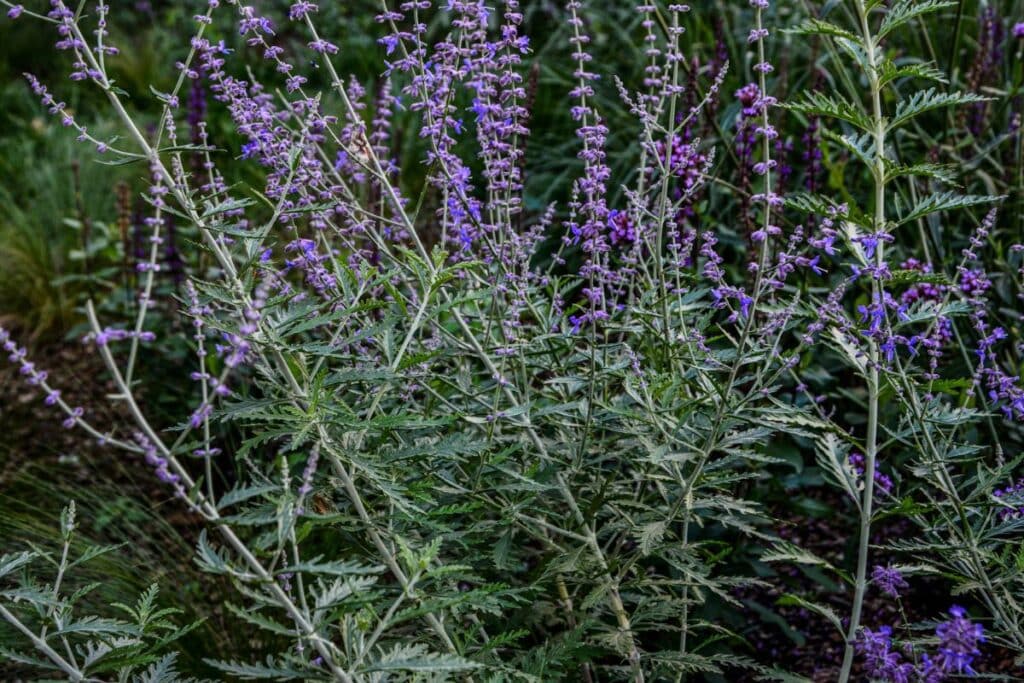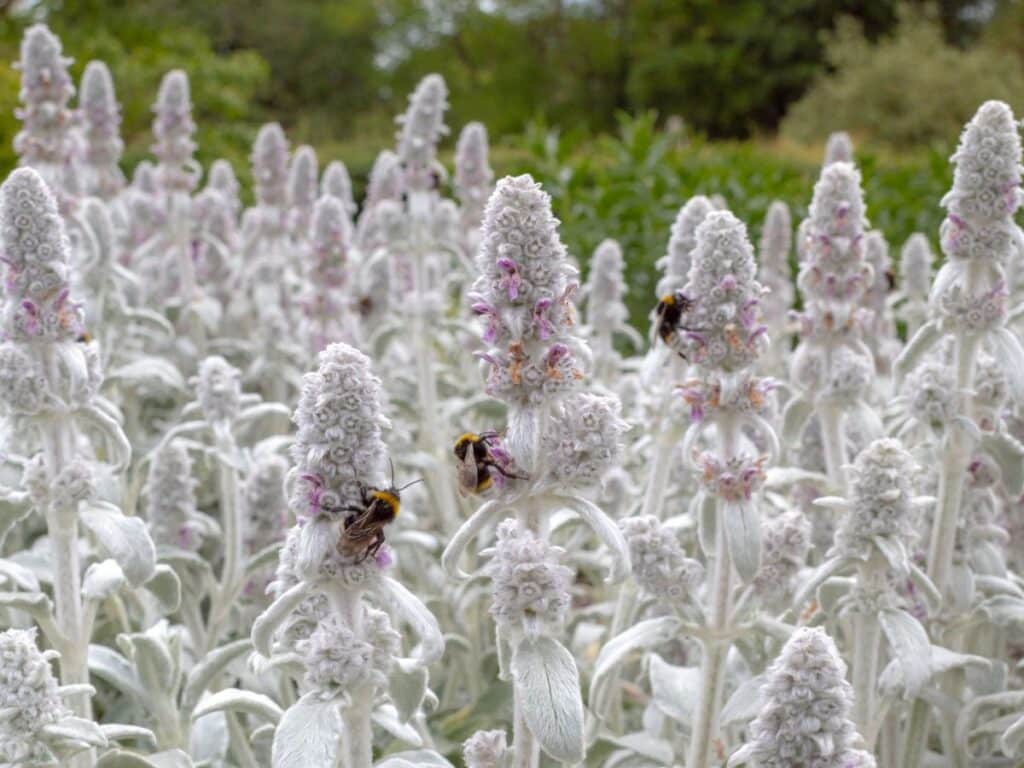Lamb’s Ear (Stachys byzantina) is a soft and attractive groundcover that will add lots of texture to your garden with its silvery appearance and velvety foliage. The plant is called wooly lamb’s ears because the leaves look like the ears of a young goat lamb and they produce purple flowers that can add lots of interest to your garden bed.
The best way to enhance the striking color and texture of this plant is by growing it next to companions like Russian sage, Shasta daisies, black-eyed Susans, white stonecrop, sweet woodruff, and daylilies.
Let’s take a closer look at these lamb’s ear companion plants and the best ways to combine them in your garden.
What to Plant with Lamb’s Ear
If you want a successful and healthy garden then it is best to pair plants with similar growing requirements in the same garden bed.
Lamb’s ears grow best in poor soil conditions, avoid wet soil. These velvety plants can be grown in full sun or partial shade, and they are very drought resistant but you should avoid sprinkling water directly on their leaves.
These plants are wonderful as border plants, garden fillers, and ground covers and they can also grow very well in containers.
Here is a closer look at how you can pair lamb’s-ear plants with the following companions to create gorgeous garden displays.
Russian Sage

As a member of the mint family, Russian sage (Perovskia atriplicifolia) is a good choice for companion planting with Lamb’s Ear because of its attractive leaves. They will, however, add more texture to your garden because their leaves are more delicate and they produce lots of purple flower stalks that can look rather striking alongside the lamb’s ear blooms.
These sage plants grow well in warm climates and they need plenty of direct sunlight to produce lots of vivid purple flowers. If grown in the shade, they won’t produce as many flowers. The herbaceous plants will grow well in average soil as long as it drains well and they are also drought tolerant.
When you are pairing these perennials with lamb’s ears, it is best to establish them in the back from where you plant lamb’s ear. These shrubs can get quite tall with a height of up to 5 feet tall and will overpower your charming lamb’s ears if they are grown in the front.
Shasta Daisies
Shasta Daisies (Leucanthemum x superbum) are great companions to grow next to your lamb’s ears because they will add lots of interest with their dark green leaves and bright white flowers. These eye catching flowers will also attract lots of butterflies, bees, and other pollinators to your garden.
These white flowers will thrive in any sunny spot as long as they are positioned in well-drained soil that is rich in nutrients. The flowers can tolerate a bit of shade but won’t flower properly in these conditions and can become leggy. They require infrequent watering and will develop root issues if they are planted in soggy soil.
White daisies will grow slightly taller than the lamb’s ear plant. If you are pairing them in a garden bed then they should be established behind your big ears. In containers, they can be grown in the center with lamb ears all around them.
Black Eyed Susan

Black Eyed Susans (Rudbeckia Hirta) can grow very well with Lamb’s ears in rocky or dry garden scapes. These charming plants produce lots of vivid yellow flowers from early summer to late fall and will look rather striking next to a border of silver lamb’s ears.
Black-eyed Susan flowers grow very well in full sun to light shade but they flower their best if they receive a minimum of six hours of direct sunlight per day. They can adapt to most soil types as long as the soil is well drained. As with lamb’s ears, they are drought resistant and shouldn’t be planted in soggy areas.
Some tall varieties of black-eyed Susan flowers can reach a height of up to 6 feet tall and should be planted behind a border or row of lambs ear plants so these two plants can create a dramatic contrast next to one another.
White Stonecrop
White stonecrop (Sedum album) are good companion plants to consider if you are looking for something shorter to grow in front of your lamb’s ears. This plant has interesting waxy foliage and produces delicate white flowers that can add lots of interest to your rock gardens.
Sedums grow very well in full sun but can tolerate a little bit of light shade so you won’t have to worry about planting them too close to your lamb’s ears. These succulents prefer sandy soils that drain well and they are extremely drought-resistant and heat tolerant.
Sedums have shorter stems with a height of about 3 inches tall and produce flowers that can reach a height of 6 inches tall. Because of their shorter stature, they are great for growing around or in front of lambs’ ear plants.
Sweet Woodruff
Sweet woodruff (Galium odoratum), also known as Wild Baby’s Breath, is another good ground cover to include in your garden if you are establishing your lamb’s ears in a dappled shade area. This perennial plant will form a mat of dark green leaves all over your garden and they produce clusters of delicate star-shaped flowers from late spring to mid-summer.
Unlike lamb’s ears, these perennials prefer a bit more shade dependent so be sure to include plenty of taller plants that can offer some shade in your mixed garden bed. They also need a bit more frequent watering but will flourish in any type of rich soil that drains well.
You can plant sweet woodruff all over your garden to make the silvery blue leaves of your lamb’s ears stand out even more. These plants are very easy to care for and will spread all over your garden bed throughout the growing season.
Daylilies

Daylilies (Hemerocallis) can be great additions if you want to add a lot of color to your garden. These plants are surprisingly easy to maintain and they produce lots of vivid and showy flowers. There are lots of different varieties which include colors like yellow, red, pink, purple, almost black, and many mixed varieties.
These flowers will produce lots of blooms if you grow them in direct sunlight but they also tolerate semi-shade positions. They will take well to any rich soil that drains well but usually prefer slightly acid soil types.
Daylilies require lots of nutrients but this can be beneficial to lamb’s ears since these velvety plants usually prefer poor soil conditions.
When the bulbs are flowering, you only need to water them once a week but you can reduce watering when they are no longer in bloom.
Gardeners love to position lamb’s ears in the front of their garden beds with lots of daylilies peeking out from behind them to create a vibrant and contrast-rich garden.
What Not To Plant with Lamb’s Ear
Lamb’s ears can be paired with all sorts of beautiful ornamental species but not all plants will look charming right next to these perennials.
It is usually best not to grow lamb’s ear plants with plants that look very similar. A plant like common mullein, for example, will be hardly noticeable next to a lamb’s ear because their leaves are too similar in appearance.
It is also best not to grow these sun-loving plants in deep shade. Lamb’s ear can tolerate a little bit of shade but will eventually die if you grow them in a humid, moist, and dark area that plants like ferns require to flourish.
Landscaping Ideas for Lamb’s Ears and Companions
Now that we discussed some great companion plants for lamb’s ear, it is time to find out a little bit more about different ways to grow them in your garden. Here is a quick look at great ways to include lamb’s ear and companions for a more stunning garden.
Rocky Gardens
Lamb’s ear is a great plant to include in rocky gardens because they don’t require too much water and are easy to maintain. This plant compared to other low-maintenance plants like black-eyed susans or sage can form a striking wild garden effect.
Desert Gardens
Lambs ears are perfect plants for desert gardens, dry gardens, or xeriscape projects because they love lots of direct sun and require little water and care.
You can certainly pair them with texture-rich succulents or other drought-tolerant plant varieties like lavender (Lavandula) or sage.
Mixed Containers
The velvety silver-green leaves of lambs’ ears are great for filling out mixed containers. You can pair these filler plants with thriller plant species like Mexican feather grass (Nassella tenuissima) or daylilies.
Your mixed container will look particularly charming if you add a waterfall effect by adding an interesting vine plant-like string of hearts (Ceropegia) that can spill over the edge of the container.
FAQs
Are lambs ears invasive?
Lamb’s ears (Stachys byzantina) can be invasive in some regions due to their spreading nature.
What is a good substitute for lambs ear?
Good substitutes for lamb’s ears include other low-growing, silvery-leaved plants like Artemisia or Cerastium.
Is lambs ear fast growing?
Lamb’s ears are generally considered fast-growing, forming dense mats of fuzzy, silver-gray foliage.
Final Thoughts
Lamb ears are great plants to include in your garden. They are useful for creating mixed containers, and borders around your garden beds and are very handy for filling out your garden. These plants are very charming if you pair them with companion plants like sage, black-eyed Susan, daylilies, sweet woodruff, white stonecrop, Shasta daisies, and quite a few other ornamentals that will complement the velvety leaves.
We hope that you had lots of fun learning about new ways to pair lamb’s ear and other plants in your garden and that this guide helped you come up with some new and creative ways to mix and match.
See more:
*image by wirestock_creators/depositphotos







